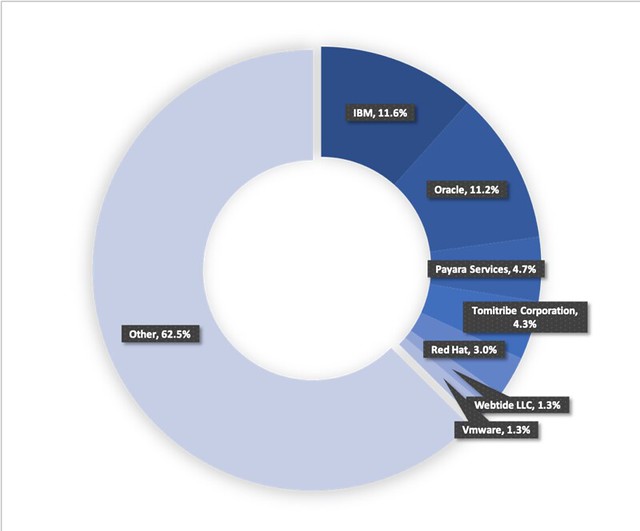Most developers know that Jakarta EE is the successor to Java EE. But they may not be fully aware of how ingrained the technologies continue to be in the industry, or why leading organizations are choosing Jakarta EE for cloud native enterprise Java applications.
In fact, many developers rely on Jakarta EE technologies every day, but don’t realize it. For example:
- Apache Tomcat implements four Jakarta EE specifications — Jakarta Servlet, Jakarta Standard Tag Library, Jakarta WebSocket, and Jakarta Authentication.
- Spring Boot embeds Apache Tomcat, Eclipse Jetty, or Undertow as a runtime.
- Eclipse Jetty implements the Jakarta Servlet, Jakarta Server Pages, and Jakarta WebSocket specifications. The Eclipse IDE, which is used by millions of developers globally, is just one example of widely used software that relies on Eclipse Jetty.
- MicroProfile implements four Jakarta EE specifications – Jakarta RESTful Web Services, Jakarta Contexts and Dependency Injection, Jakarta JSON Binding, and Jakarta JSON Processing. Other industry frameworks implement MicroProfile, which further extends the industry’s reliance on Jakarta EE specifications.
Beyond these implementations, the industry is increasingly recognizing that Jakarta EE delivers a combination of strategically important features and functions that is not available in any other Java framework. The Eclipse Foundation 2020 Jakarta EE developer survey revealed that Jakarta EE had become the second-place cloud native framework with 35 percent of nearly 2,200 survey respondents saying they use it.
Here are just a few of the reasons why Jakarta EE is taking off globally.
Jakarta EE Technologies Are Well-Understood and Widely Proven
Jakarta EE’s backwards compatibility, maturity, and stability provide a level of protection and peace of mind that is not possible with other Java frameworks.
With up to 90 percent of Fortune 500 companies still running enterprise Java applications in production, the backwards compatibility that Jakarta EE provides is key to leveraging the investments made in this massive installed base.
Also, while developers sometimes believe the most exciting new development platform best reflects their own innovative spirit, there is no advantage that outweighs the ability to consistently deliver stable and reliable software. Jakarta EE delivers all of the benefits of “boring software” — a concept that emphasizes the value of reliable software over hyped and volatile technologies that falsely claim to be the latest and greatest.
Developers Have Architectural Flexibility Today and Tomorrow
With Jakarta EE, developers have a single, cohesive framework to develop and support cloud-based architectures, including microservice architectures, as well as traditional, monolithic architectures. They can also seamlessly leverage innovative technologies, such as MicroProfile, Docker containers, and Kubernetes orchestration.
This flexibility allows developers to evolve existing Java applications in a way that makes the most of existing technology and infrastructure investments. At the same time, they can develop new, cloud native applications that increase agility, consistency, and automation.
Jakarta EE Opens the Door to Cloud Native Java Innovation
With the release of Jakarta EE 9, cloud native Java innovation is far more straightforward than it was in the past:
- The package namespace change from javax.* to jakarta.* simplifies migration to Jakarta EE 9 because it is the only change developers need to consider.
- The Jakarta EE Specification Process makes it considerably easier for products to be certified as Jakarta EE full profile and web-compatible than it was under previous processes. As a result, a growing number of tool vendors, product vendors, and custom application developers are updating their offerings to be Jakarta EE-compatible.
- Going forward, individual specifications will be updated as required, so there’s no need to wait for a full platform release to start using the advances in a particular specification.
New Innovations Come With Low Risks
Jakarta EE provides an extremely well-defined boundary between fully tested specifications and underlying implementations. This clear separation means technologies, such as a database or an application server, can be easily replaced with minimal impact on the application code.
The ability to easily switch out underlying technologies saves developers considerable time and effort when changes are required. It also keeps competitive pressure high and is a major factor in an organization’s ability to quickly transform applications to be faster and lighter and to meet modern demands at cloud scale.
With the upcoming Jakarta EE 10 release, the software is expected to include new features and functionality that take organizations into the cloud native world of containers and microservices.
There’s an Opportunity to Influence Technology Evolution
The community-based, vendor neutral approach at the Eclipse Foundation means organizations no longer need to persuade individual vendors to adapt technologies to meet their requirements, or simply hope the ecosystem evolves in alignment with their goals.
Instead, developers and users can participate equally in the Jakarta EE community to influence the direction the specifications take and ensure their needs are met. For example, developers may need another test to be added to a Jakarta EE specification to ensure that vendors developing compatible products meet a key requirement. Or they may need an enhancement to security functionality to comply with new corporate or customer requirements.
Jakarta EE Benefits Organizations of All Sizes and Types
The world leaders of the global Java ecosystem, including Fujitsu, Oracle, IBM, Payara, Red Hat, and Tomitribe, have embraced Jakarta EE and joined the Jakarta EE Working Group. The level playing field at the Eclipse Foundation has also attracted a number of innovative, smaller companies and individuals to the working group and the community.
Community members include organizations and individuals that develop and sell commercial applications based on Jakarta EE, as well as those that rely on these applications to run their businesses. All have an equal opportunity to participate in, and influence, Jakarta EE decisions to achieve important business benefits:
- Small companies can dramatically increase their global visibility, access expertise, and take advantage of market opportunities.
- Large companies can openly collaborate to reduce development costs for business-critical platforms and differentiate by building products on top of those platforms.
- Researchers, academics, and government organizations can freely leverage and collaborate on open source software that is critical to furthering their area of study or delivering on their public mandate.
- Innovators can build an open, entrepreneurial ecosystem that enables global industry players and technology adopters to collaborate and build on their innovations to benefit corporations and the public.
Today, a diverse group of organizations and individuals contribute to the Jakarta EE software.

Get the Full Story
For more insight into the benefits of Jakarta EE and why so many organizations are adopting the technologies, read our white paper, “Why Jakarta EE Is the Right Choice for Today's Java Applications.”
Join the Jakarta EE Community
Given the enthusiasm and innovation we see so far with Jakarta EE, we’re confident we’re seeing the beginnings of a renaissance in enterprise Java. We invite all enterprise Java developers to join us on the journey and help shape the future of cloud native Java.
To get started:


